
Figure 4.--Diagram of a typical hoop net (modified from Nielsen and Johnson, 1983).
Hoop nets with different mesh sizes are reported to be size selective and species selective (Starrett and Barnickol, 1955; Hubert and Schmitt, 1982; Holland and Peters, 1992). Holland and Peters (1992) compared the catch of baited hoop nets with mesh sizes of 25, 32, and 38 mm and noted that mean fish length and species diversity increased with increasing mesh size. The authors determined that 38-mm mesh hoop nets collected the greatest number of species.
Hoop nets used as part of NAWQA should be constructed of fiberglass hoops 0.6 m in diameter, with funnels on the second and fourth of the seven hoops, untreated 38-mm mesh (bar measure), and should be 3.7 m long. Hoop nets should be baited with cheese, pressed soybean cakes, or some other material and then set in the water along a steep bank or on the outside bend of the stream. The net is set by securing the cod or tapered end to a tree or post, or anchored to the bottom. The net is played out with the current until fully extended, and then is allowed to settle to the bottom. The mouth of the net is directed downstream to minimize clogging with debris. The current helps to keep the hoops separated and the net stretched. However, the mouth of the net may need to be secured to a tree, post, or anchor to ensure that the hoop net is set properly. The net is marked with a buoy for easy retrieval and identification purposes.
The duration of time that a hoop net is set depends on the same factors that influence the duration of the set of a gill net and should be determined in a similar fashion. To harvest, the hoop net is raised at the cod end and the fish are removed. Two hoop nets are set within the sampling reach, the location of which should be determined after consideration of the same factors that influence gill net locations.